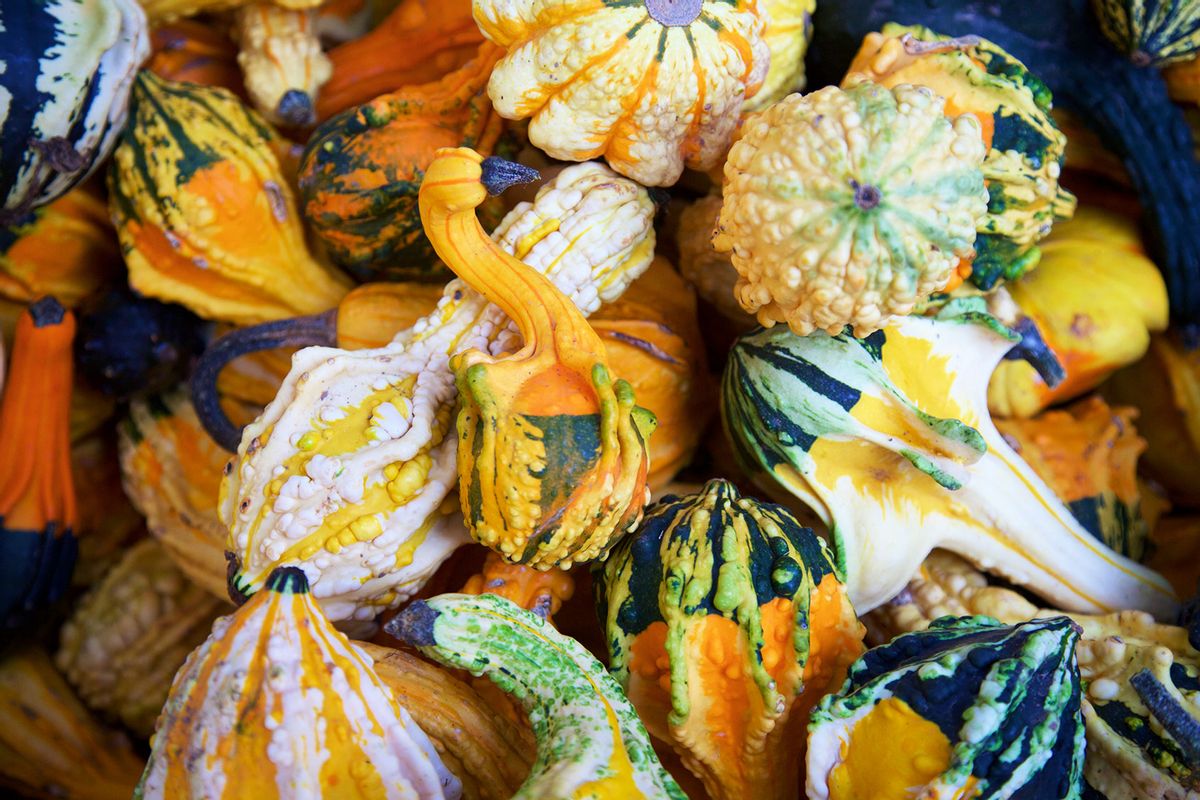What does a pumpkin have in common with a zonkey? It turns out: quite a lot.
We don't typically associate the two: Zonkey is the term for a rarely-seen zebra-donkey hybrid, while pumpkins are associated with Halloween jack-o'-lanterns, delicious desserts and trendy beverages. Yet just as a donkey can breed with a zebra to create a zonkey, so too can different types of pumpkin cross-breed with each other to create vegetables with unique designs. One of those crossbreeds involves being covered in warts.
Hence, in the case of warty pumpkins — a popular novelty gourd often sold this time of year — being covered in warts isn't necessarily a bad thing. Stop staring — it could be in their genes!
However, when it comes to other members of cucurbita — a genus of fruit in the gourd family that includes squashes and gourds — warts can be a sign of serious problems, and not genetic ones.
In other words, figuring out if the warted gourd you're looking at at the farmers market got that way because it's sick, or genetically predisposed to being wart-covered, is not always obvious. In that way, warts are somewhat akin to freckles on humans: some of us are predisposed towards harmless ones, while for others they can be a sign of skin cancer.
There are times when warted pumpkins — and, for that matter, all manner of warted cucurbits — look like that because something is terribly wrong.
Cucurbits like pumpkins are relatively unique among vegetable crops in that they produce separate male and female flowers on the same plant. The term for this is "monoecious," and because pumpkins are monoecious, they can cross pollinate with other pumpkins to create vegetables with a wide range of colors, shapes, textures and other variations. One of those potential varieties involves putting in lots and lots of seemingly ugly bumps.
Yet one person's ugly bump is another's coveted wart, at least when it comes to pumpkins. The Michigan-based Siegers Seed Co. sells so-called "Super Freak" pumpkins which are renowned for their various bump-covered visages. The owners require at least 10 generations of breeding before they will sell a pumpkin under the Super Freak label, and there is a good reason for that. As the popularity of items like theirs Knuckle Head Pumpkins reveals, Super Freak pumpkins are amazing jack-o'-lantern material.
Meanwhile, there are warty pumpkins like the pink Galeaux d'Esyines. The warts on their outside are called "corking," as horticulturalist Jessica Walliser said on WNYC. "What happens is that the sugar content gets so high in this fruit that it actually fractures the skin and then they develop these warts," she explained, noting that the flavor would thus be very sugary. Hence, some warty gourds are actually quite sweet beneath that ornamentally beautiful or weird exterior (depending on your perspective).
Want more health and science stories in your inbox? Subscribe to Salon's weekly newsletter The Vulgar Scientist.
Yet warted pumpkins don't always look that way because of genetic variety. There are times when warted pumpkins — and, for that matter, all manner of warted cucurbits — look like that because something is terribly wrong.
If your squash or zucchini is covered in bumps, it is almost certainly due to a virus or some other health problem.
One possible culprits behind a bumpy pumpkin is the mosaic virus. In addition to discoloring leaves and causing some leaves and vines to grow in too small, the mosaic virus can cover a pumpkin's surface in unsightly bumps. Insects like cucumber beetles can also give pumpkins a bumpy appearance if they start feeding on them before their shells have had a chance to harden.
While you would likely prefer to avoid pumpkins that are infested with beetles, mosaic virus-infected pumpkins are still safe to eat, although generally regarded as inferior in taste.
These same general rules apply to other cucurbits as well. If your squash or zucchini is covered in bumps, it is almost certainly due to a virus or some other health problem. Boring insects and too much calcium in the soil can cause squashes to be bumpy, as can rapid growth of the plant.
There are mosaic viruses that are named after cucumbers (cucumber mosaic), watermelon (watermelon mosaic) and zucchinis (zucchini yellow mosaic), as well as diseases like papaya ring spot. All of them can infect cucurbits and lead to discolorations as well as unsightly bumps. There is also a condition known as oedma in which water imbalances within the fruit causes the cells to grow bigger before eventually bursting, leading to scarring.
But if you're buying a warty gourd purely for decorative reasons, the source of the warts might not be that important. Unlike dogs, which are sometimes cruelly inbred to select for traits, warty pumpkins are merely briefly-held autumn trifles — even when a lot of biological science underlies their appearance.



Shares